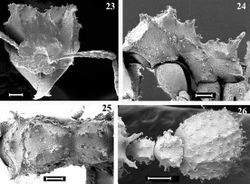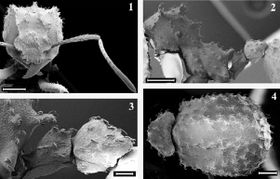Key to Trachymyrmex jamaicensis species group workers
This worker key is based on: *Mayhé-Nunes, A.J., Brandão, C.R.F. 2007. Revisionary studies on the attine ant genus Trachymyrmex Forel. Part 3: The Jamaicensis group (Hymenoptera: Formicidae). Zootaxa. 1444:1-21 (doi:10.11646/zootaxa.1444.1.1).
You may also be interested in
1
- With the body in side view, length of lateral pronotal and anterior mesonotal projections notably different, either the mesonotal is much bigger than pronotal (Fig. 10), or appears as a multitubercular low tumulus (Fig. 16) . . . . . 2
- Lateral pronotal and anterior mesonotal projections almost of the same size or the mesonotal a little shorter, but always spine-like . . . . . 3
2
return to couplet #1
- Lateral pronotal spine-like projections shorter and slenderer than anterior mesonotal ones; midpronotal projections present; pronotal inferior corner and anterior margin of katepisternum unarmed; postpetiole in dorsal view trapezoidal, little broader behind than in front, its postero-dorsal border straight . . . . . Trachymyrmex isthmicus (Figs 9–12)
- Lateral pronotal spine-like projections longer than tumuliform and multituberculated anterior mesonotal ones; midpronotal projections absent or obsolete; pronotal inferior corner and anterior margin of upper region of katepisternum armed with a notable triangular tooth; postpetiole in dorsal view broader than long, its posterior border concave . . . . . Mycetomoellerius ixyodus (Figs. 15–18)
3
return to couplet #1
- Apically spatulate curved coarse hairs distributed over the whole body (Figs. 3, 26) . . . . . 4
- Curved coarse hairs apically spatulate absent over the whole body, except gaster . . . . . 5
4
return to couplet #3
- Antennal scape scarcely surpassing the posterior margin of head when lodged in the scrobe, with head in frontal view; anterior margin of the crenate frontal lobe with a protruded pointed tooth; propodeal spines distinctly longer than the distance between their inner bases (better seen in postero-dorsal view) . . . . . Mycetomoellerius zeteki (Figs 23–26)
- Antennal scape surpassing the posterior margin by nearly a third of its length, when lodged in the scrobe, with head in frontal view; anterior margin of the smooth frontal lobe unarmed; propodeal spines distinctly shorter than the distance between their inner bases (better seen in postero-dorsal view) . . . . . Trachymyrmex atlanticus (Figs 1–5, 30)
5
return to couplet #3
- Base of the anterior mesonotal spine thicker than the base of lateral pronotal ones; midpronotal projections absent or rarely represented by a pair of minute separate spines; supraocular projection spine-like; head and gaster darker than yellowish brown mesosoma; last funicular segments as dark as antennal scapes . . . . . Mycetomoellerius jamaicensis (Figs 19–22)
- Base of the anterior mesonotal spine almost as thin as the base of lateral pronotal ones; midpronotal projection represented by a single truncate tooth; supraocular projection absent or vestigial; the whole body dark reddish brown; last funicular segments lighter than other antennal segments . . . . . Mycetomoellerius haytianus (Figs 5–8)
















